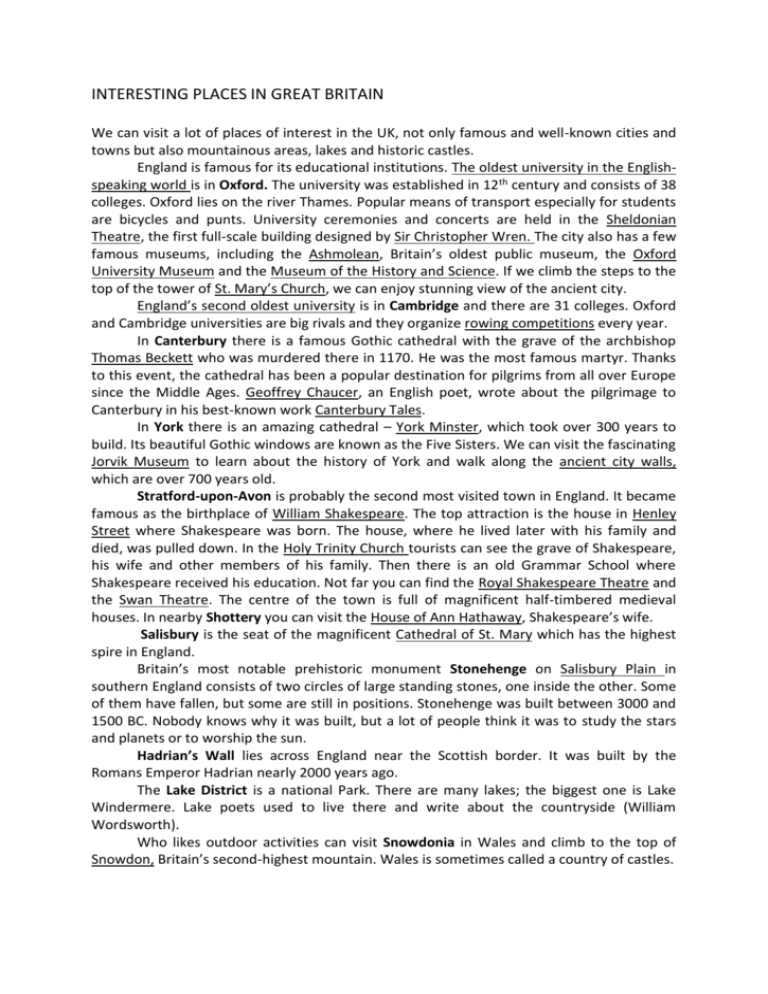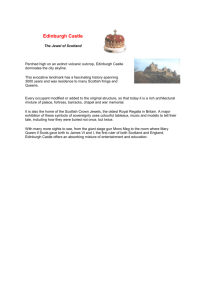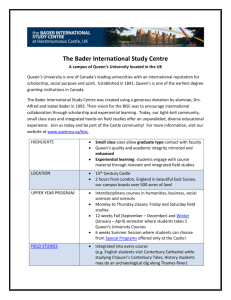INTERESTING PLACES IN GREAT BRITAIN
advertisement

INTERESTING PLACES IN GREAT BRITAIN We can visit a lot of places of interest in the UK, not only famous and well-known cities and towns but also mountainous areas, lakes and historic castles. England is famous for its educational institutions. The oldest university in the Englishspeaking world is in Oxford. The university was established in 12th century and consists of 38 colleges. Oxford lies on the river Thames. Popular means of transport especially for students are bicycles and punts. University ceremonies and concerts are held in the Sheldonian Theatre, the first full-scale building designed by Sir Christopher Wren. The city also has a few famous museums, including the Ashmolean, Britain’s oldest public museum, the Oxford University Museum and the Museum of the History and Science. If we climb the steps to the top of the tower of St. Mary’s Church, we can enjoy stunning view of the ancient city. England’s second oldest university is in Cambridge and there are 31 colleges. Oxford and Cambridge universities are big rivals and they organize rowing competitions every year. In Canterbury there is a famous Gothic cathedral with the grave of the archbishop Thomas Beckett who was murdered there in 1170. He was the most famous martyr. Thanks to this event, the cathedral has been a popular destination for pilgrims from all over Europe since the Middle Ages. Geoffrey Chaucer, an English poet, wrote about the pilgrimage to Canterbury in his best-known work Canterbury Tales. In York there is an amazing cathedral – York Minster, which took over 300 years to build. Its beautiful Gothic windows are known as the Five Sisters. We can visit the fascinating Jorvik Museum to learn about the history of York and walk along the ancient city walls, which are over 700 years old. Stratford-upon-Avon is probably the second most visited town in England. It became famous as the birthplace of William Shakespeare. The top attraction is the house in Henley Street where Shakespeare was born. The house, where he lived later with his family and died, was pulled down. In the Holy Trinity Church tourists can see the grave of Shakespeare, his wife and other members of his family. Then there is an old Grammar School where Shakespeare received his education. Not far you can find the Royal Shakespeare Theatre and the Swan Theatre. The centre of the town is full of magnificent half-timbered medieval houses. In nearby Shottery you can visit the House of Ann Hathaway, Shakespeare’s wife. Salisbury is the seat of the magnificent Cathedral of St. Mary which has the highest spire in England. Britain’s most notable prehistoric monument Stonehenge on Salisbury Plain in southern England consists of two circles of large standing stones, one inside the other. Some of them have fallen, but some are still in positions. Stonehenge was built between 3000 and 1500 BC. Nobody knows why it was built, but a lot of people think it was to study the stars and planets or to worship the sun. Hadrian’s Wall lies across England near the Scottish border. It was built by the Romans Emperor Hadrian nearly 2000 years ago. The Lake District is a national Park. There are many lakes; the biggest one is Lake Windermere. Lake poets used to live there and write about the countryside (William Wordsworth). Who likes outdoor activities can visit Snowdonia in Wales and climb to the top of Snowdon, Britain’s second-highest mountain. Wales is sometimes called a country of castles. The first son of English kings holds the title Prince of Wales. At the Caernarfon Castle Prince Charles became officially The Prince Of Wales. In Wales there is a village with the longest name in the world. Balmoral Castle has been the summer residence of the Royal Family since Queen Victoria’s reign. The castle was a present for The Queen Victoria from her husband, Prince Albert, in 1852. The original castle was too small, so they completed a new one in 1856. Today the Queen Elizabeth II. and her family always stay at Balmoral when they visit Scotland. The castle has been open to the public for over 35 years, but visitors can only enter the ballroom because the other rooms are the Queen’s private residence. The countryside around the castle is spectacular, and includes Lochnagar, a mountain which is 1160 metres high. The north of Scotland is called the Highlands because there are a lot of mountains, including Ben Nevis (1343 m), the highest mountain in the UK. There are also woods and beautiful lakes. One of the most famous tourist attractions in this region is Loch Ness, home of the Loch Ness monster. The other Scottish lake Loch Lomond is called the Queen of Scottish lakes. In Edinburgh, the capital of Scotland, we can visit Edinburgh Castle and see the crown jewels of Scotland and the “Stone of Destiny”, on which generations of Scottish and British kings and queens have been crowned. The castle dominates the skyline of the city. The Palace of Holyroodhouse, the Queen´s official residence while in Scotland, is among the notable places in Edinburgh.





